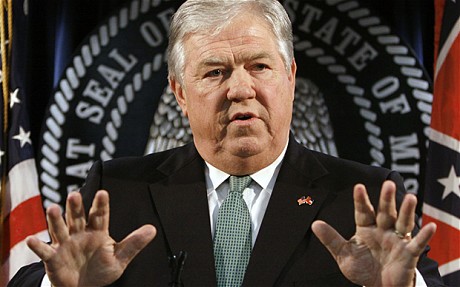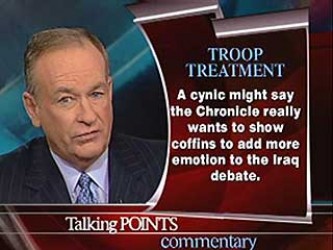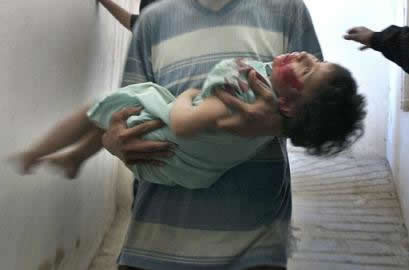Alex Constantine - January 21, 2015
Also see: BBC News, "American Sniper: Was Chris Kyle really a hero?" -- "Amy Nicholson of Slate takes particular aim at Kyle's book, which she says contains jingoistic braggadocio and some clear falsehoods - such as his assertion that he killed two carjackers in Texas and shot looters following Hurricane Katrina in New Orleans. Eastwood, she writes, should have addressed this. Instead, he 'pretended Kyle never claimed any of it. But when a film erases the fact that its subject was a fabricator, then that itself is a lie' ..."
--------------
American Sniper has turned out to be the dark horse in this year’s Oscar race, landing six nominations last Thursday despite being largely ignored by other awards shows. (It received no Golden Globe or SAG nominations.) Directed by Clint Eastwood and starring Bradley Cooper, the film is based on Navy SEAL Chris Kyle’s autobiography of the same name—which, in turn, is based on Kyle’s memory. The book will serve as “fact” for the purposes of this article, as it and conversations with Kyle were the film’s primary source material.
Kyle, who served four tours between 2003 and 2009, is the most lethal sniper in American history: The government credits him with 160 confirmed kills. (The previous record was 109, set during the Vietnam war.) Kyle was involved in the making of this movie; he discussed his life and book with Cooper and screenwriter Jason Hall. He was killed on February 2, 2013–just one day after screenwriter Hall submitted his script. The piece was then amended through conversations between Hall and Kyle’s wife, Taya, as well as conversations between Taya and Eastwood, Hall, and Cooper. Taya has spoken positively of the movie, saying it’s “brought her husband back to life.”
The movie has come under heated criticism. It has been accused of glorifying the life of a bloodthirsty killer, being ignorant of the U.S. criminality in Iraq, acting as pro-war propaganda, and over-indulging in depictions of the local culture’s “savagery.” Kyle does call Iraqis “savages” and “evil” in his book, and while he hesitates before his first sniper kill, that is the only instance of doubt he records. Kyle’s only mention of torture comes in the descriptions of torture he and his fellow SEALs endured during training.
GET MORE EW: Subscribe to the magazine for only 33¢ an issue!
Kyle also discusses the rules of engagement more than once in his book. While those mentions are rarely positive—often, Kyle writes that he feels bound to follow rules that his opponents do not—he always details complying. That said, Kyle’s own credibility was called into question after he claimed that he beat up former Minnesota governor and professional wrestler Jesse Ventura, that the government paid him to shoot looters from the Superdome following Hurricane Katrina, and that he shot and killed two carjackers in Dallas. None of these claims have been verified; Ventura has since won a defamation lawsuit against Kyle’s estate.
Only an allusion to the Ventura incident appears in his book. In the text, Kyle beats up a guy in a bar he calls “Scruff Face”; in post-publication interviews, he identified the character as Ventura. Neither of the other two incidents appear in the book or movie. As for specific changes between Eastwood’s film and its source material:
Movie: Chris Kyle enlists at 30 after quitting the rodeo, breaking up with his girlfriend, and seeing the 1998 bombings of U.S. embassies on the news.
Book: Kyle enlists at 24. He retires from the rodeo after a ride his freshman in college year leaves him severely injured. He works as a ranch hand/cowboy for the rest of college, dropping out his senior year to enlist.
Joining the military is a much less abrupt decision in the book than in the movie—Kyle considers enlisting before college, but chooses to get his education first and enlist later at the urging of his family. He’s initially rejected from the SEALs due to his rodeo injuries (he has pins in both wrists) and pursues a full-time career as a ranch hand before a Navy recruiter reaches out, asking him to join the services.
 Movie: Taya and Chris fall in love shortly after he completes training. They have a whirlwind romance and marry shortly after 9/11. He finds out he is deploying at their wedding.
Movie: Taya and Chris fall in love shortly after he completes training. They have a whirlwind romance and marry shortly after 9/11. He finds out he is deploying at their wedding.
Book: Taya and Chris do have a whirlwind romance, but they choose to marry when they do because of his impending deployment. He’s given three days leave from training for his wedding and honeymoon.
Movie: Kyle is a trained sniper prior to deployment.
Book: While this isn’t explicitly stated in the movie, it’s detailed extensively in the book. Kyle deploys for his first tour in Kuwait as a SEAL, entering sniper training only after upon returning to the States.
Movie: Kyle’s first kills as a sniper are a woman and her child in Fallujah.
Book: This is Kyle’s first sniper kill, though it happens while he is technically still training to be a sniper. He kills a woman–not her and her child–when she pulls out a grenade in the street. The incident occurs soon after Kyle’s arrival in Fallujah, though this is his second tour of duty; he’s already completed one tour in Kuwait and spent a month working with the Polish special forces in Baghdad.
Movie: Kyle and his fellow snipers spend time hunting down a terrorist known as “The Butcher.”
Book: “The Butcher” is never mentioned in the book, though the character is likely based on Iraqi Shia warlord and executioner of the Sunnis Abu Deraa.
Movie: Kyle and the SEALs spend a decent part of Chris’ tours hunting an opposition sniper named Mustafa. In the final battle scene of the movie—during his fourth and final tour—Kyle records a 2,100-yard shot, killing Mustafa.
Book: Kyle mentions Mustafa in his book, but only in one paragraph. Kyle is aware and on the lookout for the Olympian shooter, but says he never sees him and does not take responsibility for Mustafa’s death. Kyle does complete a 2,100-yard kill, and the depiction of the shot is largely correct in the movie adaptation—going after a shooter on a distant rooftop—but the man on the other end of the shot is not Mustafa.
Movie: While on the phone with Taya, Kyle is surprised to learn his younger brother has deployed. Later, when he sees his brother on a tarmac, his brother makes disparaging comments (“F— this place!”) about the war.
Book: Kyle is aware his younger brother is deploying, and often mentions the anxiety he feels when he comes upon a group of fallen soldiers; he’s always terrified he’ll come upon his brother’s body. His brother’s impression of the war is never addressed.
Movie: Ryan “Biggles” Job is blinded by a bullet. He survives for a short while, and proposes to his girlfriend in the hospital. Kyle visits him there before leaving for his fourth tour, learning of Ryan’s death almost immediately upon arrival in Iraq.
Book: Ryan (Kyle alternates between his real name and nickname) is blinded in battle, but lives much longer post-injury than in the movie. He is discharged from service, gets married, goes to college, gets a job, climbs Mount Hood and Mount Rainer, and more. His injury does require further treatment, and he does die on the table from surgical complications when his wife is pregnant with their first child. Kyle learns of his death by a phone call from close friend Marcus Luttrell (the author of Lone Survivor, which also became a major motion picture).
Movie: Navy SEAL Marc Lee becomes disillusioned with war and later dies in the field. At the service—which Kyle attends with Taya in the States—his mother reads aloud a letter in which Lee laments the pointlessness of war. Later, Taya and Kyle fight about the letter; Kyle claims Lee’s attitude caused his death.
Book: Kyle and his camp have a memorial for Lee at base, but Kyle does not get to pay his graveside respects to Lee until he’s on leave and at at a funeral for a SEAL from another platoon, Mike Monsoor. Kyle speaks highly of the letter Lee wrote his mother a few days prior to his death.
Movie: Kyle calls Taya from the convoy. Taya is in the middle of telling him the sex of their first child when they come under fire. He drops the phone, and Taya is left distraught, unable to know whether he’s alive.
Book: Kyle often has to call home while out on patrols, because the fighting is so frequent that if he waits for a stint back at base, it could be a week before he’d be able to reach his wife. On two occasions, he comes under fire while on the phone; once, when he calls Taya while on night patrol in Baghdad, he comes under fire and drops the phone. He doesn’t realize he hadn’t disconnected or that she can hear the battle. The phone dies, and Kyle can’t call her back for several days.
 Movie: Much is made of the$180,000 bounty placed on Kyle’s head; he’s presented as the most wanted man in Iraq. We see a poster with his tattoos that’s being circulated.
Movie: Much is made of the$180,000 bounty placed on Kyle’s head; he’s presented as the most wanted man in Iraq. We see a poster with his tattoos that’s being circulated.
Book: There is a bounty placed on Kyle’s head, though it’s not as large as it is in the movie. It starts at $20,000 and ends around $80,000, as he explained in an interview on Conan. A similar bounty is rewarded for the killing of any American sniper.
Movie: During his second tour, Kyle and his group raid houses for intel and spend the night in a house with a man, his wife, and their child for a stakeout. While eating dinner with them, Kyle discovers a cache of weapons for the insurgency in the home.
Book: There is no mention of this in Kyle’s book. He discusses plenty of raids in plenty of towns, but never specifically spending time in one of them and discovering weapons in their home.
Movie: After Kyle kills Mustafa in the movie’s final battle scene, he calls Taya and tells her he’s finally ready to come home. He becomes depressed, and it appears to be because the memories of war are too much to bear.
Book: Kyle promises Taya before his fourth tour that he will not re-up after it ends. The decision comes during a time of particular marital crisis—Taya and Kyle fight about this issue between all of his tours. Taya argues that Kyle needs to be home to help her raise their children; Kyle argues that his duty is to his country. Guilt over this leaving the service plagues Kyle for years; he lets himself go physically, drinks heavily, and admittedly suffers from depression. He writes, “I loved what I did, I still do. If circumstances were different—if my family didn’t need me—I’d be back in a heartbeat. I’m not lying or exaggerating to say it was fun. I had the time of my life being a SEAL.”
Generally speaking, in the book, Kyle depicts himself as a heads-down soldier, questioning neither his mission nor his actions—let alone the politics of Operation Iraqi Freedom. (He occasionally questions the tactics of his superiors.) He is black-and-white with his judgements and beliefs, more so than as depicted in the movie. Maybe he needed that mindset to survive in a war zone, but he never says so explicitly.
In Jason Hall’s “Bonus Material” chapter included in the movie tie-in edition ofAmerican Sniper, the screenwriter attributes these differences to his post-mortem script revision. After Kyle’s death, Hall spent more time speaking with Taya. In turn, he came to understand his protagonist as a more well-rounded man: “Out of those conversations I got a side of Chris I hadn’t understood before, and I saw how the movie had to be rewritten. I gained insights from her that I couldn’t have gotten from him. People can’t see themselves the way others do… She filled in a lot of blanks.”
Movie: On the day Chris is killed, he and Taya have a conversation in which she thanks him for working so hard to get back to being the man she loves. He leaves to go out with a Marine vet whose mother had called to say he was having a hard time after returning Stateside.
Book: This never happens in the book; the memoir was already in stores by the time Kyle was killed. In Hall’s “Bonus Material,” he tells us that the conversation was real, and that it happened a month or so before February 2, 2013, when Kyle was killed with his neighbor Chad Littlefield. Eddie Ray Routh is the Marine in question; he is currently awaiting trial on two counts of capital murder.







Dear People,
I appreciated meeting a 2 mile sniper who quit doing it after a few hundred kills when he zero’d in on a man with his child and just quit after that. That was enough murder for him.
Lyle Courtsal http://www.3mpub.com
Dear People,
Another friend told me that snipers were killing 3,000 people a month in Vietnam, our worst war that wasn’t a war. It’s this business as usual that is killing both us and our collective future together.
Lyle Courtsal http://www.3mpub.com, http://www.narconews.com,
http://www.leap.cc, http://www.norml.org (uhoh, independent scientific studies)
The really sad thing is that ordinary people caught up in too many tours become suicidal without help. If you can’t find help, look up http://www.orthomed.org and http://www.orthomolecular.org for ways over the counter that will stabilize your brain chemistry again. This is called megavitamin therapy.
Dear People,
I just found about a program in Nova Scotia called Marijuana for Trauma for using cannabis for treating PTSD. See also Sergeant Northcutt’s Post-Iraq Nightmare archived at http://www.alternet.org about his odyssey through the dark side when he used cannabis to treat his PTSD. Then there’s http://www.orthomed.org which teaches megavitamin therapy for psychological conditions that are much less toxic than mainline prescription drug treatments. There’s also http://www.orthomolecular.org too. Abram Hoffer was treating out even intensive schizophrenia with megavitamin therapy; later used it in conjunction with meds only the minimum needed (support coalition international). Also there is a four page A-Z medical marijuana use index at http://www.rxmarijuana.com; Lester Grinspoon MD’s website out of Canada. Finally I love feeding my brain with superfood drinks like Columbia Gorge Vitasea Superfood Drink with the huge amount of spirulina and chlorella algae in them. It is believed that this mix of algae’s prevented radiation uptake in the Chernobyl kids. Love ya,
Lyle Courtsal http://www.3mpub.com, http://www.leap.cc
http://www.hemptrade.ca, www,norml.org
Other orthomolecular medicine pioneers: Klenner, Osmond, Pauling, Hoffer, Kalokerinos (Australia-see http://www.whale.to-the nutritional medicine section). And that is http://www.norml.org. Let’s get 1,000,000 nonviolent prisoners out of jail and into permanent medically supported housing. It’s cheaper and much more socially and personally beneficial.
Lyle Courtsal
PS for solar job creation info., see Institute for Local Self-Reliance.
Finally, remember one of the first things US forces did in Iraq was kill off all those pesky college intellectuals, most anyone they could catch; rmmbr?